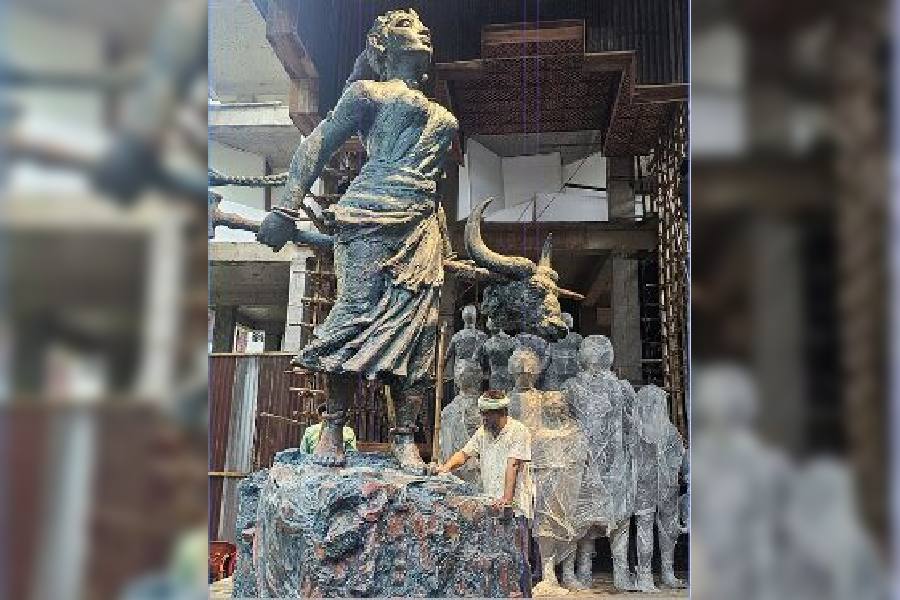She stands tall, her face raised as if looking adversary and adversity in the eye, her gaze scorching. Behind her, half a dozen figures follow, dwarfed by her but drawing from her strength.
Her features and posture are nothing like the imperious deity’s. Nor is she the village mother that one comes across in idyllic pandals depicting rural Bengal. This woman, standing at a side of the podium at the Arjunpur Amra Sabai Club grounds, off VIP Road, is Ganadebata, the deity of the masses.
“I had no plans of making the idol this year and was in talks with a Kumartuli idol-maker. But the events in Manipur rattled me. I have no words to describe what happened there or what I felt. I just knew I had to create an idol. My creation is my response,” Bhabatosh Sutar, renowned artist and Puja theme-maker, told The Telegraph.
The deity, about 15ft in height, is a figure of defiance, who stands her ground after being trampled, taking the lead for all the tribal women who have been assaulted and insulted in Manipur and elsewhere.
“There is no reference to Manipur anywhere in the pandal but her features are like a tribal woman’s, as are her sparse accessories. In any strife, it is the women who are the soft targets. So my Durga is Everywoman,” Sutar said.
She has bruises on her body, too.
“The idol is always shown to be perfect, not a strand of hair out of place. Why should that be?” he asked.
The rough texture of Sutar’s Durga therefore bears witness to all that she has suffered.
Last year, the little-known Arjunpur puja had pulled visitors all the way to an alley in Baguiati to witness the daily ballad of the workers’ life, performed live in a cyclical act, which was archived in a beautifully produced bilingual book, Mathe Ghate Shilpa/Art on Ground, chronicling Sutar’s journey as a theme-maker culminating in the Arjunpur puja.
There will be performances this year, too, with Sutar himself joining in.
“For me, Durga Puja itself is a performance. What I am presenting is a procession in clay, an embodiment of an uprising from the grassroots of society in reaction to the atrocities we have seen in Manipur. My pandal will send out social, economic and political messages,” he said.
Which is why Nazrul Islam’s poem Bidrohi (Rebel) will be played on the sound system, with the opening line, “Bolo bir bolo unnata mama shir”, defining Sutar’s creation and urging visitors to rise and not to tamely accept the status quo of injustice and inequity.
Durga’s off-springs will be walking in the procession, too, shoulder to shoulder with common people. It is as if Durga is leading the rally of protesters. As part of the performance, 10 people will take turns to spray water on the figures and keep the figures wet and fertile.
“The spectators are expected to lend a hand, too. Otherwise there is no point in a mass congregation,” Sutar said.
A clay installation with a bamboo pole (khuti) will bear the eight remaining hands of the 10-handed goddess. Visitors can add lumps of clay to that, in a symbolic act of strengthening her hand.
Sutar himself is present in his creation. Two motorised likenesses of his faces in iron-fibre alloy will clash head-on from time to time, creating a tremendous sound that would cause everything to stop and the area to plunge in darkness. “If I had my way, I’d have these faces crack and start breaking into pieces,” Sutar said.
While admitting this was an expression of his own rage and frustration, Sutar wants to leave the interpretation to the spectators. “It could even be my way of shedding the demon within.”
The second part of the book will be released on October 14.
“Puja pandals are ephemeral, ending with the goddess’s immersion, so that there is a new beginning the next year. But there should be a documentation of the effusion of creativity that takes place in the locality over six months for our next generation of members,” Mousumi Dutta, the committee president of the puja, said.
